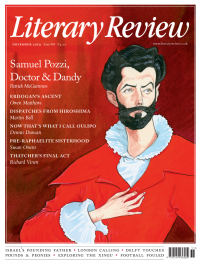Charles Elliott
The £569 Pineapple
An Economic History of the English Garden
By Roderick Floud
Allen Lane 398pp £25
According to An Economic History of the English Garden, between 1820 and the present day, 15,652 gardening books have been published in the UK alone. That’s not the most astonishing number in this book, but it does make you wonder whether there is really room for another one. Roderick Floud thinks so, and succeeds in proving his point, largely by contemplating the horticultural phenomenon coldly and unsentimentally in terms of one thing: money.
And what a lot of money! Beginning with the great gardens of the 18th century, which were formed by the aristocracy and other grandees (including, of course, royals able to beautify their acreage with the aid of public funds), right up to the garden centres and allotments of today, the English have spent, by Floud’s calculations, almost unbelievable amounts. Here are a few examples (all figures reflect today’s values): between 1760 and 1800, the Crown laid out between £800 million and £1 billion on parks and gardens; the lake and dam at Blenheim took six years to build and two more to fill, and cost the fourth Duke of Marlborough £35 million; the sixth Duke of Devonshire paid £25.6 million for the Great Stove, a huge conservatory designed by Joseph Paxton, at Chatsworth; in the 1770s, the designer Lancelot ‘Capability’ Brown earned £20 million working for the banker Robert Drummond at Cadland, where he created what is described as one of his ‘smallest gardens’; it is estimated that in 1868 it cost £569 to produce one pineapple; an Atco lawnmower would set you back £10,500 in 1921.
If these numbers appear out of line, we must recognise that to arrive at them Floud has chosen a slightly unorthodox method. Instead of simply multiplying the actual figure expended in, say, 1700 by the change in the value of a pound since then, he compares the change

Sign Up to our newsletter
Receive free articles, highlights from the archive, news, details of prizes, and much more.@Lit_Review
Follow Literary Review on Twitter
Twitter Feed
It wasn’t until 1825 that Pepys’s diary became available for the first time. How it was eventually decrypted and published is a story of subterfuge and duplicity.
Kate Loveman tells the tale.
Kate Loveman - Publishing Pepys
Kate Loveman: Publishing Pepys
literaryreview.co.uk
Arthur Christopher Benson was a pillar of the Edwardian establishment. He was supremely well connected. As his newly published diaries reveal, he was also riotously indiscreet.
Piers Brendon compares Benson’s journals to others from the 20th century.
Piers Brendon - Land of Dopes & Tories
Piers Brendon: Land of Dopes & Tories - The Benson Diaries: Selections from the Diary of Arthur Christopher Benson by Eamon Duffy & Ronald Hyam (edd)
literaryreview.co.uk
Of the siblings Gwen and Augustus John, it is Augustus who has commanded most attention from collectors and connoisseurs.
Was he really the finer artist, asks Tanya Harrod, or is it time Gwen emerged from her brother’s shadow?
Tanya Harrod - Cut from the Same Canvas
Tanya Harrod: Cut from the Same Canvas - Artists, Siblings, Visionaries: The Lives and Loves of Gwen and Augustus John by Judith Mackrell
literaryreview.co.uk